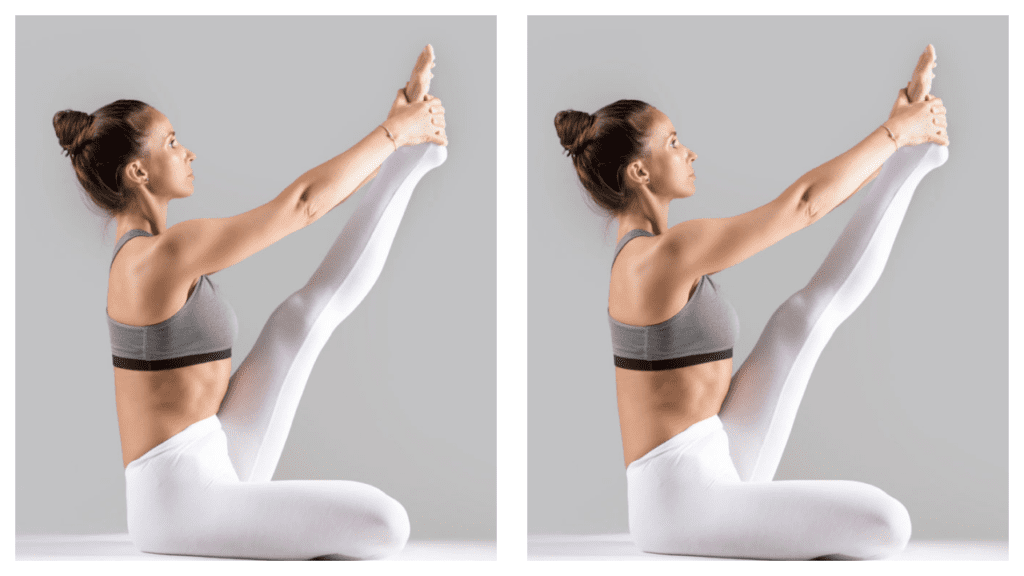Have you ever watched a heron standing still in a calm lake, waiting patiently for its next meal to swim by? It’s the picture of grace and concentration. Similarly, in the world of yoga, the Heron Pose (Krounchasana) offers a mix of serene balance and challenging flexibility. Let’s embark on a journey to understand and master this beautiful pose, making your yoga practice even more fulfilling and transformative. Whether you’re a beginner or an experienced yogi, this guide will help you deepen your practice and connect with your inner grace.

What is the Heron Pose?
The Yoga Heron Pose, known in Sanskrit as Krounchasana, is a seated yoga posture that focuses on stretching the hamstrings and stimulating the abdominal organs. It’s named for the heron because it resembles the bird’s stance when it extends its leg forward to catch a fish. This pose is part of the intermediate series in Ashtanga yoga, and it combines elements of balance, strength, and flexibility to create a comprehensive body engagement.
warmup before Yoga Heron Pose
Warming up before diving into the Yoga Heron Pose is crucial for preventing injuries and enhancing your flexibility. Start with gentle stretches that target your hamstrings, calves, and back. Dynamic movements like leg swings and walking lunges can also prepare your muscles and joints. A thorough warm-up primes your body and focuses your mind, setting the stage for a successful and safe practice.
Step-by-Step Guide to Entering Heron Pose
Ready to try it out? Here’s how you can ease into the Heron Pose:
- Start Seated: Begin in a seated position with your legs stretched out in front of you, and your spine erect.
- Bend Your Right Knee: Slowly bend your right knee, bringing the foot towards you, and keeping the left leg active and grounded.
- Lift Your Right Leg: Using both hands, clasp your right foot or wrist. Gently lift your right leg, extending it upward and outward, as if mimicking the heron’s precise movement.
- Maintain Balance: Keep your back straight and balance on your sitting bones, ensuring your core is engaged.
- Hold and Breathe: Hold this position for a few breaths, focusing on a steady, smooth inhale and exhale, then gently release and repeat on the other side.
Curious about more yoga poses? Check out our detailed guide on “Elephant Yoga Pose” for another enriching addition to your practice!
Benefits of Heron Pose
Practicing this pose can offer you numerous benefits:
- Enhances flexibility in the legs, particularly the hamstrings, helping to alleviate tightness and promote better circulation.
- Strengthens the back muscles, which can lead to improved posture and reduced back pain.
- Stimulates the abdominal organs, improving digestion and helping to detoxify the body.
- Improves posture and balance, which can be beneficial in daily activities and other physical pursuits.
Common Mistakes to Avoid
Avoid these common mistakes to get the most out of your Heron Pose:
- Rushing into the pose can lead to strain or injury. Take it slow and steady.
- Ignoring pain in your knees or back. Listen to your body and modify as needed, using props or adjusting the pose.
Who Should Avoid Heron Pose?
While beneficial, the Heron Pose isn’t for everyone:
- Those with knee or ankle injuries should avoid this pose or approach it with extra caution, as it puts significant stress on these joints.
- Individuals with lower back issues should perform this pose under the guidance of a professional, and possibly avoid it if it causes pain.
Modifications for Beginners
If you’re finding the traditional Heron Pose challenging, try these modifications:
- Use a yoga strap around your foot to help lift your leg while maintaining alignment.
- Perform the pose near a wall or with a chair to help maintain balance and ensure safety.
Curious about more yoga poses? Check out our detailed guide on “Yoga Starfish Pose” for another enriching addition to your practice!
Advanced Variations
For those who have mastered the basic pose and want a challenge:
- Try holding the toe instead of the ankle or calf, which requires more flexibility and balance.
- Increase the hold time gradually to build endurance and deepen the pose’s impact.
Integrating Heron Pose into Your Yoga Routine
Incorporate Heron Pose into your yoga sequence to enhance flexibility and strength. It pairs well with forward bends and seated poses, and can serve as a peak pose or a preparatory pose for deeper stretches.
What to Pair with Heron Pose
In creating a balanced session, you might include:
- Forward bends: like Paschimottanasana (Seated Forward Bend) to complement the stretch and further open the hamstrings.
- Twists: like Marichyasana (Marichi’s Pose) to enhance the spinal rotation and provide a counterpose to the intense leg stretch.
Listening to Your Body
Always pay attention to what your body is telling you during your practice. If you feel sharp pain, especially in the knee or back, gently exit the pose and consult with a yoga instructor. Adjusting the pose to meet your body’s needs can help prevent injury and ensure a beneficial practice.
Curious about more yoga poses? Check out our detailed guide on “Running Man Yoga Pose” for another enriching addition to your practice!
The Spiritual Aspect of Heron Pose
Beyond physical benefits, Heron Pose can enhance your meditation practice by promoting calm and focus. The pose mimics the heron’s stillness, encouraging a meditative state that connects mind, body, and spirit.
Conclusion
- Improves flexibility and digestion.
- Strengthens the body and enhances mental focus.
- Accessible to beginners with modifications and challenging for advanced practitioners.
Dare to try the Heron Pose in your next yoga session? It might just transform your practice by bringing a new level of grace and challenge. How do you plan to incorporate this elegant pose into your routine? What new insights or benefits do you hope to achieve?